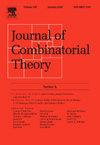On nontrivial cross-t-intersecting families
IF 1.2
2区 数学
Q2 MATHEMATICS
引用次数: 0
Abstract
Two families and are called nontrivial cross-t-intersecting if for all , and . In this paper we will determine the upper bound of for nontrivial cross-t-intersecting families and for positive integers n, k, ℓ and t such that and . The structures of the extremal families attaining the upper bound are also characterized. As a byproduct of the main result in this paper, one product version of Erdős–Ko–Rado Theorem for two families of cross-t-intersecting can be easily obtained which gives a confirmative answer to one conjecture by Tokushige.
关于非平凡的交叉交集族
对于所有A∈A, B∈B, |A∈A∪BA|<t,当|A∩B|≥t时,称两个族A ([n]k)和B ([n] r)为非平凡正交相交。在正整数n、k、r、t的条件下,确定非平凡正交族A ([n]k)和B ([n] r)的|A||B|的上界,使n≥max (t+1)(k−t+1),(t+1)(r−t+1)}, t≥3。对达到上界的极族结构也进行了表征。作为本文主要结果的副产品,我们可以很容易地得到两族交叉相交的Erdős-Ko-Rado定理的一个乘积版本,从而证实了Tokushige的一个猜想。
本文章由计算机程序翻译,如有差异,请以英文原文为准。
求助全文
约1分钟内获得全文
求助全文
来源期刊
CiteScore
2.90
自引率
9.10%
发文量
94
审稿时长
12 months
期刊介绍:
The Journal of Combinatorial Theory publishes original mathematical research concerned with theoretical and physical aspects of the study of finite and discrete structures in all branches of science. Series A is concerned primarily with structures, designs, and applications of combinatorics and is a valuable tool for mathematicians and computer scientists.

 求助内容:
求助内容: 应助结果提醒方式:
应助结果提醒方式:


